Electricity
Electricity
Question 1:
By what other name is the unit joule/coulomb called ?
Solution :
Volt
Question 2:
Which of the following statements correctly defines a volt ?
(a) a volt is a joule per ampere.
(b) a volt is a joule per coulomb.
Solution :
(b) a volt is a joule per coulomb.
Question 3:
(a) What do the letters p.d. stand for ?
(b) Which device is used to measure p.d. ?
Solution :
(a) p.d. stands for potential difference.
(b) Voltmeter is used to measure p.d.
Question 4:
What is meant by saying that the electric potential at a point is 1 volt ?
Solution :
Electric potential at a point is 1 volt means 1 joule of work is done in moving 1 unit positive charge from infinity to that point.
Question 5:
How much work is done when one coulomb charge moves against a potential difference of 1 volt ?
Solution :
Potential difference = 1 V
Charge moved = 1C
Work done = Potential difference x Charge moved
= 1 x 1 = 1 J
Question 6:
What is the SI unit of potential difference ?
Solution :
Volt
Question 7:
How much work is done in moving a charge of 2 C across two points having a potential difference of 12 V ?
Solution :
Given,
Potential difference = 12 V,Charge moved = 2 C
We know that,
Work done= p.d. x charge moved
= 12 x 2
= 24 joules.
Question 8:
What is the unit of electric charge ?
Solution :
Coulomb
Question 9:
Define one coulomb charge.
Solution :
One coulomb of charge is that quantity of charge which exerts a force of 9 × 109 Newton on an equal charge is placed at a distance of 1 m from it.
Question 10:
Fill in the following blanks with suitable words :
(a) Potential difference is measured in………….. by using a……………. placed in………… across a component.
(b) Copper is a good………….. Plastic is an……………
Solution :
(a) volts; voltmeter; parallel
(b) conductor; insulator
Question 11:
What is meant by conductors and insulators ? Give two examples of conductors and two of insulators.
Solution :
Conductors:- Those substances through which electricity can flow are known as conductors. E.g., Copper, silver etc.
Insulators:- Those substances through which electricity cannot flow are known as insulators. E.g., Plastic, cotton etc.
Question 12:
Which of the following are conductors and which are insulators ?
Sulphur, Silver, Copper, Cotton, Aluminium, Air, Nichrome, Graphite, Paper, Porcelain, Mercury, Mica, Bakelite, Polythene, Manganin.
Solution :
Conductor:- Silver, Copper, Aluminum, Nichrome, Graphite, Mercury, Manganin
Insulators:- Sulphur, Cotton, Air, Paper, Porcelain, Mica, Bakelite, Polythene
Question 13:
What do you understand by the term “electric potential” ? (or potential) at a point ? What is the unit of electric potential ?
Solution :
The electric potential (or potential) at a point in an electric field is defined as the work done in moving a unit positive charge from infinity to that point.
Unit of electric potential is volt.
Question 14:
(a) State the relation between potential difference, work done and charge moved.
(b) Calculate the work done in moving a charge of 4 coulombs from a point at 220 volts to another point at 230 volts.
Solution :
(a) Potential difference = Work done/Charge moved.
(b) V1=220 V, V2=230V, Charge moved=4C
Thus, the potential difference= V2- V1 =230-220
=10.
We know that,
Work done = Potential difference x Charge moved
= 10 x 4
Work done = 40 joules
Question 15:
(a) Name a device that helps to measure the potential difference across a conductor.
(b) How much energy is transferred by a 12 V power supply to each coulomb of charge which it moves around a circuit ?
Solution :
(a) Voltmeter
(b) Given : Potential difference=12V, Charge moved=1C
We know that,
Work done = Potential difference x charge moved
= 12 x 1 = 12 joules
Since work done on each coulomb of charge is 12 joules, the energy given to each coulomb of charge is also 12 joules.
Question 16:
(a) What do you understand by the term “potential difference” ?
(b) What is meant by saying that the potential difference between two points is 1 volt ?
(c) What is the potential difference between the terminals of a battery if 250 joules of work is required to transfer 20 coulombs of charge from one terminal of battery to the other ?
(d) What is a voltmeter ? How is a voltmeter connected in the circuit to measure the potential difference between two points. Explain with the help of a diagram.
(e) State whether a voltmeter has a high resistance or a low resistance. Give reason for your answer.
Solution :
(a) Potential difference between two points in an electric circuit is defined as the amount of work done in moving a unit charge from one
point to the other point.
(b) The potential difference between two points is 1 volt means 1 joule of work is done in moving 1 coulomb of electric charge from one point to the other.
(c) Given: Work done = 250J, Charge moved = 20C.
we know that,Potential difference = Work done/Charge moved
=250/20=12.5
(d) A voltmeter is a device which is used to measure the potential difference between two points in an electric circuit. Voltmeter is always connected in parallel across the two points where the potential difference is to be measured.
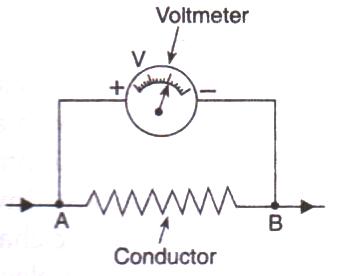
(e) Voltmeter has a high resistance so that it takes a negligible current from the circuit.
Question 22:
Three 2 V cells are connected in series and used as a battery in a circuit.
(a) What is the p.d. at the terminals of the battery ?
(b) How many joules of electrical energy does 1 C gain on passing through (i) one cell (ii) all three cells ?
Solution :
(a) If three cells of 2 volt each are connected in series to make a battery, then the total potential difference between terminals of the battery will be 6V.
(b) (i) Given: p.d. = 2V, Charge moved = 1C
We know that
Work done = p.d. x charge moved
= 2 x 1
Work done = 2 joules
(ii) Given: p.d. = 6V, Charge moved = 1C
Work done = p.d. x charge moved
= 6 x1
Work done = 6 joule.
Question 23:
The atoms of copper contain electrons and the atoms of rubber also contain electrons. Then why does copper conduct electricity but rubber does not conduct electricity ?
Solution :
Copper has free electrons that are loosely held by the nuclei of the atoms. These free electrons result in conduction of electricity.
The electrons present in rubber are strongly held by the nuclei of its atoms. So, rubber does not have free electrons to conduct electricity.
Question 1:
By what name is the physical quantity coulomb/second called ?
Solution :
Ampere
Question 2:
What is the flow of charge called ?
Solution :
Electric Current.
Question 3:
What actually travels through the wires when you switch on a light ?
Solution :
Electrons.
Question 4:
Which particles constitute the electric current in a metallic conductor ?
Solution :
Electrons.
Question 5:
(a) In which direction does conventional current flow around a circuit ?
(b) In which direction do electrons flow ?
Solution :
(a) Conventional current flows from positive terminal of a battery to the negative terminal, through the outer circuit.
(b) Electrons flow from negative terminal to positive terminal of the battery (opposite to the direction of conventional current).
Question 6:
Which of the following equation shows the correct relationship between electrical units ?
1 A = 1 C/s or 1 C = 1 A/s
Solution :
1A = 1C/s
Question 7:
What is the unit of electric current ?
Solution :
Ampere.
Question 8:
(a) How many milliamperes are there in 1 ampere ?
(b) How many microamperes are there in 1 ampere ?
Solution :
(a) 1 amp = 103 milli amp.
(b) 1 amp = 106 micro amp.
Question 9:
Which of the two is connected in series : ammeter or voltmeter ?
Solution :
Ammeter is connected in series.
Question 10:
Compare how an ammeter and a voltmeter are connected in a circuit.
Solution :
Ammeter is connected in series in a circuit whereas voltmeter is connected in parallel.
Question 11:
What do the following symbols mean in circuit diagrams ?

Solution :
(i) Variable resistance.
(ii) A closed plug key.
Question 12:
If 20 C of charge pass a point in a circuit in 1 s, what current is flowing ?
Solution :
Given, Q = 20 C, t=1s
I=?
We know that:
I=Q/t.
I=20/1=20A.
Question 13:
A current of 4 A flows around a circuit for 10 s. How much charge flows past a point in the circuit in this time ?
Solution :
Given, I=4amp, C, t=10s Q=?
We know that:
I=Q/t.
Q=4*10=40C.
Question 14:
What is the current in a circuit if the charge passing each point is 20 C in 40 s ?
Solution :
Given, Q = 20 C, t=1s
I=?
We know that:
I=Q/t.
Thus I=20/40=0.5A.
Question 15:
Fill in the following blanks with suitable words :
(a) A current is a flow of……….. For this to happen there must be a………….
(b) Current is measured in……… using an………… placed in……… in a circuit.
Solution :
(a) electrons; closed
(b) amperes; ammeter; series.
Question 16:
(a) Name a device which helps to maintain potential difference across a conductor (say, a bulb).
If a potential difference of 10 V causes a current of 2 A to flow for 1 minute, how much energy is
transferred ?
Solution :
(a) Cell or battery helps to maintain potential difference across a conductor.
(b) Given: p.d. = 10 V, I = 2amp, t = 1 min = 60s.
We know that:
I=Q/t.
Thus, Q=Ixt.
Q=2×60.
Q=120 C.
Work done = p.d. x charge moved
Work done = 120x10J
Work done = 1200J.
Question 17:
(a) What is an electric current ? What makes an electric current flow in a wire ?
(b) Define the unit of electric current (or Define ampere).
Solution :
(a) An electric currrent is a flow of electric charges (electrons) through a conductor.
Potential difference between the ends of the wire makes electric current to flow in the wire.
(b) When 1 coulomb of charge flows through any cross-section of a conductor in 1 second, the electric current flowing through it is said to be 1 ampere.
Question 18:
What is an ammeter ? How is it connected in a circuit ? Draw a diagram to illustrate your answer.
Solution :
Ammeter is a device used for the measurement of electric current. It is always connected in series with the circuit in which the current is to be measured. please
Question 19:
(a) Write down the formula which relates electric charge, time and electric current.
(b) A radio set draws a current of 0.36 A for 15 minutes. Calculate the amount of electric charge that flows through the circuit.
Solution :
(a). Work done = Potential difference x charge moved.
(b). I=0.36A, t=15min =900seconds.
Q=Ixt
=0.36×900
=324C.
Question 20:
Why should the resistance of :
(a) an ammeter be very small ?
(b) a voltmeter be very large ?
Solution :
(a) The resistance of an ammeter should be very small so that it may not change the value of the current flowing in the circuit.
(b) The resistance of a voltmeter should be very large so that it takes a negligible current from the current.
Question 21:
Draw circuit symbols for (a) fixed resistance (b) variable resistance (c) a cell (d) a battery of three cells (e) an open switch (f) a closed switch.
Solution :
Question 22:
What is a circuit diagram ? Draw the labelled diagram of an electric circuit comprising of a cell, a resistor, an ammeter, a voltmeter and a closed switch (or closed plug key). Which of the two has a large resistance : an ammeter or a voltmeter ?
Solution :
A diagram which indicates how different components in a circuit have been connected by using the electrical symbols for the components is called a circuit diagram.
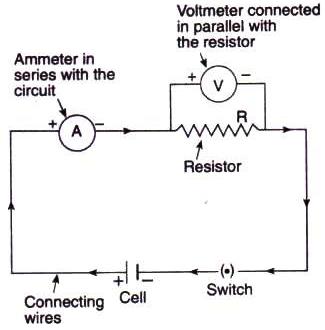
A voltmeter has a large resistance.
Question 23:
If the charge on an electron is 1.6 x 10-19 coulombs, how many electrons should pass through a conductor in 1 second to constitute 1 ampere current ?
Solution :
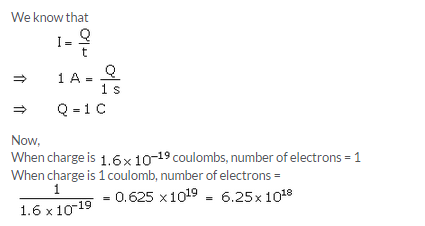
Question 24:
The p.d. across a lamp is 12 V. How many joules of electrical energy are changed into heat and light when :
(a) a charge of 1 C passes through it ?
(b) a charge of 5 C passes through it ?
(c) a current of 2 A flows through it for 10 s ?
Solution :
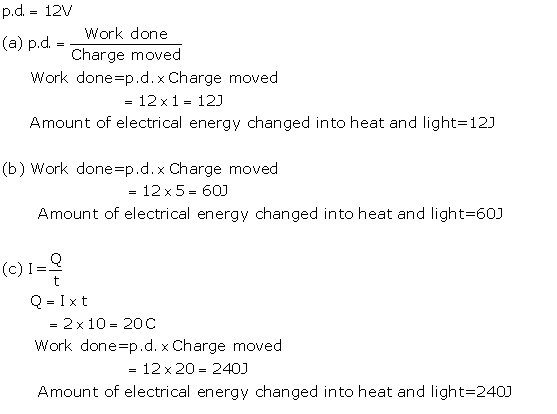
Question 25:
In 10 s, a charge of 25 C leaves a battery, and 200 j of energy are delivered to an outside circuit as a result.
(a) What is the p.d. across the battery ?
(b) What current flows from the battery ?
Solution :

Question 26:
(a) Define electric current. What is the SI unit of electric current.
(b) One coulomb of charge flows through any cross-section of a conductor in 1 second. What is the current flowing through the conductor ?
(c) Which instrument is used to measure electric current ? How should it be connected in a circuit ?
(d) What is the conventional direction of the flow of electric current ? How does it differ from the direction of flow of electrons ?
(e) A flash of lightning carries 10 C of charge which flows for 0.01 s. What is the current ? If the voltage is 10 MV, what is the energy ?
Solution :
(a) Electric current is the flow of electric charges (electrons) in a conductor such as a metal wire.
SI unit of electric current is ampere.
(b) 1 ampere.
(c) An ammeter is used to measure electric current. It should be connected in series with the circuit.
(d) Conventional direction of flow of electric current is from positive terminal of a battery to the negative terminal, through the outer circuit. The direction of flow of electrons is opposite to the direction of conventional current, i.e. from negative terminal to positive terminal.
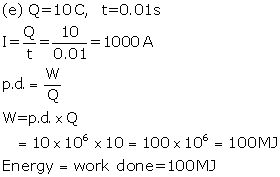
Question 32:
A student made an electric circuit shown here to measure the current through two lamps.
(a) Are the lamps in series or parallel ?
(b) The student has made a mistake in this circuit.
What is the mistake ?
(c) Draw a circuit diagram to show the correct way to connect the circuit.
Use the proper circuit symbols in your diagram.

Solution :
(a) Lamps are in series.
(b) Student has connected ammeter in parallel with lamps. It should be connected in series.
(c)
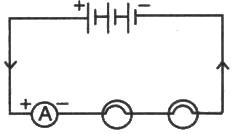
Question 33:
Draw a circuit diagram to show how 3 bulbs can be lit from a battery so that 2 bulbs are controlled by the same switch while the third bulb has its own switch.
Solution :
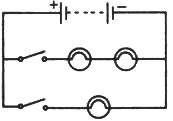
Question 34:
An electric heater is connected to the 230 V mains supply. A current of 8 A flows through the heater.
(a) How much charge flows around the circuit each second ?
(b) How much energy is transferred to the heater each second ?
Solution :
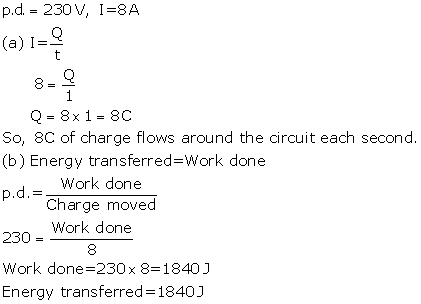
Question 35:
How many electrons are flowing per second past a point in a circuit in which there is a current of 5 amp ?
Solution :
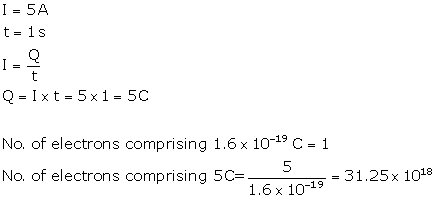
Lakhmir Singh Physics Class 10 Solutions Page No:18
Question 1:
Name the law which relates the current in a conductor to the potential difference across its ends.
Solution :
Ohm’s law
Question 2:
Name the unit of electrical resistance and give its symbol.
Solution :

Question 3:
Name the physical quantity whose unit is “ohm”.
Solution :
Electric resistance.
Question 4:
What is the general name of the substances having infinitely high electrical resistance ?
Solution :
Insulators.
Question 5:
Keeping the resistance constant, the potential difference applied across the ends of a component is halved. By how much does the current change ?
Solution :

Question 6:
State the factors on which the strength of electric current flowing in a given conductor depends.
Solution :
Strength of electric current flowing in a given conductor depends on
(i) potential difference across the ends of the conductor
(ii) resistance of the conductor.
Question 7:
Which has less electrical resistance : a thin wire or a thick wire (of the same length and same material) ?
Solution :
Thick wire.
Question 8:
Keeping the potential difference constant, the resistance of a circuit is halved. By how much does the current change ?
Solution :
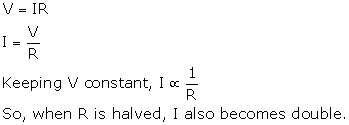
Question 9:
A potential difference of 20 volts is applied across the ends of a resistance of 5 ohms. What current will flow in the resistance ?
Solution :
Potential difference, V = 20V
Resistance, R = 5ohms
Current, I = ?
We know that
V=IR
20 = I x 5
I = 20/5 = 4 A
Question 10:
A resistance of 20 ohms has a current of 2 amperes flowing in it. What potential difference is there between its ends ?
Solution :
R = 20ohms
I = 2amp
We know that
V = IR
Thus,
V = 2 x 20
V = 40V
Question 11:
A current of 5 amperes flows through a wire whose ends are at a potential difference of 3 volts. Calculate the resistance of the wire.
Solution :
I = 5amp
p.d., V = 3V
We know that
V=IR
Thus,
3 = 5 x R
R = 3/5 = 0.6 ohm
Question 12:
Fill in the following blank with a suitable word :
Ohm’s law states a relation between potential difference and……………………
Solution :
current.
Question 13:
Distinguish between good conductors, resistors and insulators. Name two good conductors, two resistors and two insulators.
Solution :
Those substances which have very low electrical resistance are called as good conductors. E.g., copper and aluminium.
Those substances which have comparatively high resistance than conductors are known as resistors. E.g., nichrome and manganin.
Those substances which have infinitely high electrical resistance are called insulators. E.g., rubber and wood.
Question 14:
Classify the following into good conductors, resistors and insulators :
Rubber, Mercury, Nichrome, Polythene, Aluminium, Wood, Manganin, Bakelite, Iron, Paper, Thermocol, Metal coin
Solution :
Conductor :- mercury, aluminum, iron, metal coin
Resistor :- manganin, nichrome
Insulator :- rubber, polythene, wood, bakelite, paper, thermocol
Lakhmir Singh Physics Class 10 Solutions Page No:19
Question 15:
What is Ohm’s law ? Explain how it is used to define the unit of resistance.
Solution :
Ohm’s law gives a relationship between current (I) and potential difference (V). According to ohm’s law: At constant temperature, the current flowing through a conductor is directly proportional to the potential difference across its ends.
If I is the current flowing through a conductor and V is the p.d. across its ends, then according to the ohm’s law:
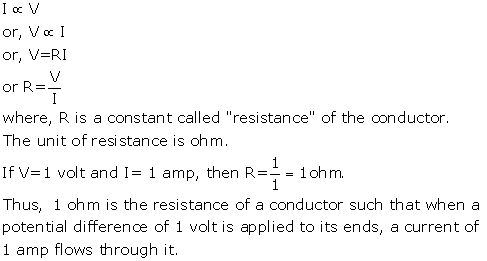
Question 16:
(a) What is meant by the “resistance of a conductor” ? Write the relation between resistance, potential
difference and current.
(b) When a 12 V battery is connected across an unknown resistor, there is a current of 2.5 mA in the circuit. Calculate the value of the resistance of the resistor.
Solution :
(a) The property of a conductor due to which it opposes the flow of current through it is called resistance of the conductor.
Work done = Potential difference x charge moved.
(b) V = 12volt, I=2.5 x 10-3 A
We know that
V=IR
R=V/I
R=12/(2.5X10-3)
R=4.8X103ohm = 4800 ohm.
Question 17:
(a) Define the unit of resistance (or Define the unit “ohm”).
What happens to the resistance as the conductor is made thinner ?
Keeping the potential difference constant, the resistance of a circuit is doubled. By how much does the current change ?
Solution :
(a) 1 ohm is the resistance of a conductor such that when a potential difference of 1 volt is applied to its ends, a current of 1ampere flows through it.
(b) Its resistance will increase.
(c)
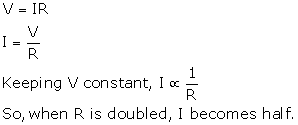
Question 18:
(a) Why do electricians wear rubber hand gloves while working with electricity ?
(b) What p.d. is needed to send a current of 6 A through an electrical appliance having a resistance of 40 Ω ?
Solution :
(a) Electricians wear rubber hand gloves while working with electricity because rubber is an insulator and protects them from electric shocks.
(b) I=6amp, R=40ohm
We know that
V=IR
V = 6 x 40 = 240 V.
Question 19:
An electric circuit consisting of a 0.5 m long nichrome wire XY, an ammeter, a voltmeter, four cells of 1.5 V each and a plug key was set up.
(i) Draw a diagram of this electric circuit to study the relation between the potential difference maintained between the points ‘X’ and ‘Y’ and the electric current flowing through XY.
(ii) Following graph was plotted between V and I values :

What would be the values of ratios when the potential difference is 0.8 V, 1.2 V and 1.6 V respectively ? What conclusion do you draw from these values ?
(iii) What is the resistance of the wire ?
Solution :
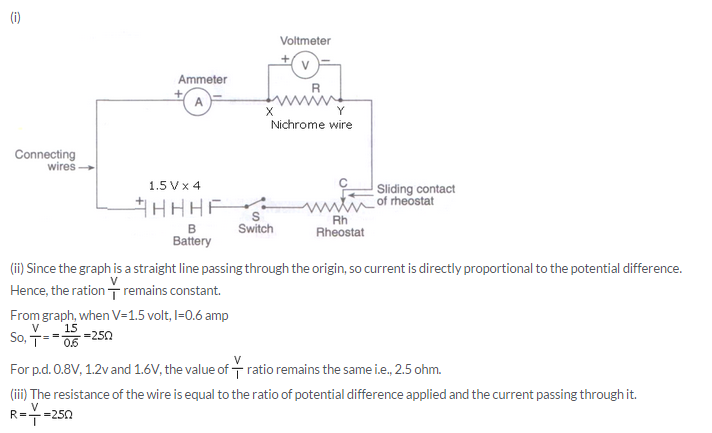
Question 20:
(a) What is the ratio of potential difference and current known as ?
(b) The values of potential difference V applied across a resistor and the corresponding values of current I
flowing in the resistor are given below :

(c) Name the law which is illustrated by the above V-I graph.
(d) Write down the formula which states the relation between potential difference, current and resistance,
(e) The potential difference between the terminals of an electric iron is 240 V and the current is 5.0 A. What is the resistance of the electric iron ?
Solution :
(a) The ratio of potential difference and current is known as resistance.
(c) Ohm’s law
(d) Potential difference = Current x Resistane
(e) V = 240 volt, I = 5amp
We know that
V=IR
240 = 5 x R
R = 240/5 = 48 ohm.
PAGE 30:
Question 30:
An electric room heater draws a current of 2.4 A from the 120 V supply line. What current will this room heater draw when connected to 240 V supply line ?
Solution :
In first case,
I = 2.4 amp, V = 120 volt
V=IR
120 = 2.4 x R
R = 120/2.4 = 50 ohm
In second case,
V = 240 volt, R = 50 ohm
V = IR
240 = I x 50
I =4.8 amp.
Question 31:
Name the electrical property of a material whose symbol is “omega”.
Solution :
Resistance.
Question 32:
The graph between V and 1 for a conductor is a straight line passing through the origin.
Which law is illustrated by such a graph ?
What should remain constant in a statement of this law ?
Solution :
(a) Ohm’s law
(b) Temperature.
Question 33:
A p.d. of 10 V is needed to make a current of 0.02 A flow through a wire. What p.d. is needed to make a current of 250 mA flow through the same wire ?
Solution :
In first case,
I = 0.02 amp, V = 10 volt
V=IR
10 = 0.02 x R
R = 10/0.02 = 500 ohm
In second case,
I = 250 x 10-3 amp, R = 500 ohm
V = IR
V = 250 x 10-3 x 500
V = 125 volt.
Question 34:
A current of 200 mA flows through a 4 kΩ resistor. What is the p.d. across the resistor ?
Solution :
I = 200mA = 0.2 A
R = 4 x 103ohm = 4000 ohm
We know that
V=IR
V = 0.2 x 4000
V = 800 volt.
Lakhmir Singh Physics Class 10 Solutions Page No:26
Question 1:
What happens to the resistance as the conductor is made thicker ?
Solution :
The resistance decreases.
Question 2:
If the length of a wire is doubled by taking more of wire, what happens to its resistance ?
Solution :
Resistance also gets doubled.
Question 3:
On what factors does the resistance of a conductor depend ?
Solution :
Resistance of a conductor depends on the following factors:-
Length of the conductor, area of cross section of the conductor, nature of material of the conductor and temperature of the conductor.
Question 4:
Name the material which is the best conductor of electricity.
Solution :
Silver metal.
Question 5:
Which among iron and mercury is a better conductor of electricity ?
Solution :
Iron.
Question 6:
Why are copper and aluminium wires usually used for electricity transmission ?
Solution :
Because copper and aluminium have very low resistivities.
Question 7:
Name the material which is used for making the heating element of an electric iron.
Solution :
Nichrome.
Question 8:
What is nichrome ? State its one use.
Solution :
Nichrome is an alloy of nickel, chromium, manganese ad iron having a resistivity of about 60 times more than that of copper. It is used for making the heating elements of electrical heating appliances.
Question 9:
Give two reasons why nichrome alloy is used for making the heating elements of electrical appliances.
Solution :
Nichrome alloy is used for making the heating elements of electrical appliances because:
(i) nichrome has very high resistivity
(ii) nichrome does not undergo oxidation (or burn) easily even at high temperature.
Question 10:
Why are the coils of electric irons and electric toasters made of an alloy rather than a pure metal ?
Solution :
Because
(i) resistivity of an alloy is much higher than that of a pure metal
(ii) an alloy does not undergo oxidation (or burn) easily even at high temperature.
Question 11:
Which has more resistance :
(a) a long piece of nichrome wire or a short one ?
(b) a thick piece of nichrome wire or a thin piece ?
Solution :
(a) A long piece of nichrome wire.
(b) A thin piece of nichrome wire.
Question 12:
(a) How does the resistance of a pure metal change if its temperature decreases ?
(b) How does the presence of impurities in a metal affect its resistance ?
Solution :
(a) On decreasing the temperature, the resistance decreases.
(b) Presence of impurities in a metal increases the resistance.
Question 13:
Fill in the following blanks with suitable words :
Resistance is measured in…………….. The resistance of a wire increases as the length…………………. ; as the
temperature………. ; and as the cross-sectional area…………
Solution :
Ohms; increases; increases; decreases.
Question 14:
(a) What do you understand by the “resistivity” of a substance ?
A wire is 1.0 m long, 0.2 mm in diameter and has a resistance of 10 Ω. Calculate the resistivity of its material ?
Solution :
(a) Resistivity is the characteristic property of a substance which depends on the nature of the substance and its temperature. It is numerically equal to the resistance between the opposite faces of a 1 m cube of the substance.
(b) l = 1m
r = d/2 = 0.2/2 mm = 0.1 mm = 0.0001m,
R = 10 ohm
We know that,
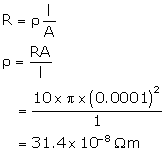
Question 15:
(a) Write down an expression for the resistance of a metallic wire in terms of the resistivity.
What will be the resistance of a metal wire of length 2 metres and area of cross-section 1.55 × 10-6 m2, if the resistivity of the metal be 2.8 × 10-8 Ωm ?
Solution :
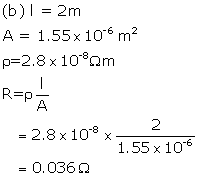
Question 16:
(a) Give two examples of substances which are good conductors of electricity. Why do you think they are
good conductors of electricity ?
Calculate the resistance of a copper wire 1.0 km long and 0.50 mm diameter if the resistivity of copper is 1.7 × 10-8 Ωm.
Solution :
(a) Silver and copper are good conductors of electricity because they have free electrons available for conduction.
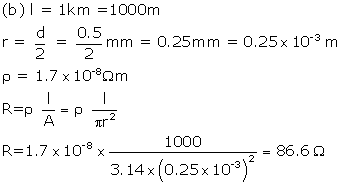
Question 17:
Will current flow more easily through a thick wire or a thin wire of the same material when connected to the same source ? Give reason for your answer.
Solution :
Current will flow more easily through thick wire because the resistance of the thick wire will be lesser than that of thin wire.
Question 18:
How does the resistance of a conductor depend on :
(a) length of the conductor ?
(b) area of cross-section of the conductor ?
(c) temperature of the conductor ?
Solution :
(a) Resistance of a conductor increases (or decreases) with increase (or decrease) in the length of the conductor.
(b) Resistance of a conductor decreases (increases) with increase (decrease) in the area of cross-section of the conductor.
(c) Resistance of a conductor increases on raising the temperature and decreases on lowering the temperature.
Question 19:
(a) Give one example to show how the resistance depends on the nature of material of the conductor.
(b) Calculate the resistance of an aluminium cable of length 10 km and diameter 2.0 mm if the resistivity of aluminium is 2.7 x 10-8Ωm.
Solution :
(a) If we take two similar wires of same length and same diameter, one of copper metal and other of nichrome alloy, we will find that the resistance of nichrome wire is about 60 times more than that of the copper wire. This shows that the resistance depends on the nature of material of the conductor.
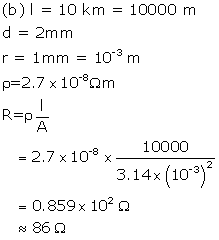
Question 20:
What would be the effect on the resistance of a metal wire of :
(a) increasing its length ?
(b) increasing its diameter ?
(c) increasing its temperature ?
Solution :
(a) Resistance will increase.
(b) Resistance will decrease.
(c) Resistance will increase.
Question 21:
How does the resistance of a wire vary with its :
(a) area of cross-section ?
(b) diameter ?
Solution :
(a) By increasing the area of cross section, the resistance will decrease.
(b) By increasing the diameter, the resistance will decrease.
Lakhmir Singh Physics Class 10 Solutions Page No:27
Question 22:
How does the resistance of a wire change when :
(i) its length is tripled ?
(ii) its diameter is tripled ?
(in) its material is changed to one whose resistivity is three times ?
Solution :
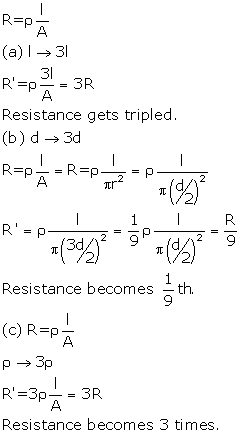
Question 23:
Calculate the area of cross-section of a wire if its length is 1.0 m, its resistance is 23 Ω and the resistivity of the material of the wire is 1.84 x 10-6Ωm.
Solution :
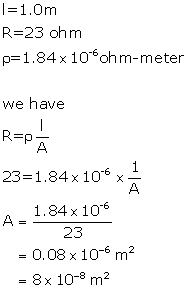
Question 24:
(a) Define resistivity. Write an expression for the resistivity of a substance. Give the meaning of each symbol
which occurs in it.
(b) State the SI unit of resistivity.
(c) Distinguish between resistance and resistivity.
(d) Name two factors on which the resistivity of a substance depends and two factors on which it does not depend.
(e) The resistance of a metal wire of length 1 m is 26 Ω at 20°C. If the diameter of the wire is 0.3 mm, what will be the resistivity of the metal at that temperature ?
Solution :
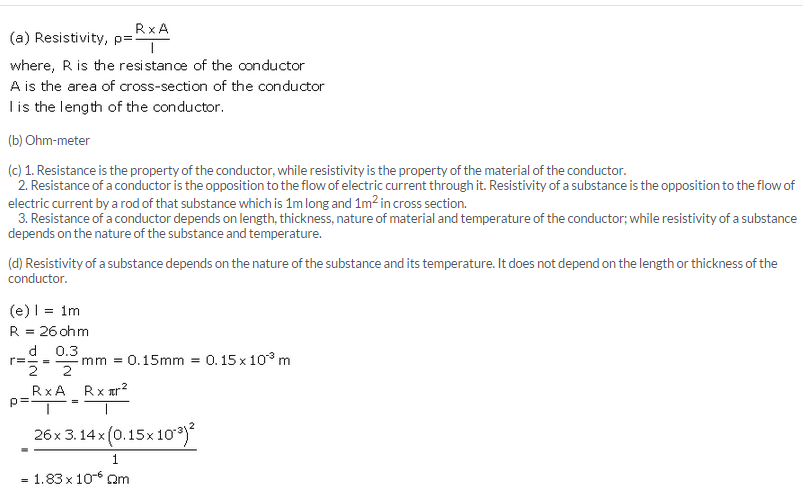
Question 33:
A piece of wire of resistance 20 Ω is drawn out so that its length is increased to twice its original length. Calculate the resistance of the wire in the new situation.
Solution :
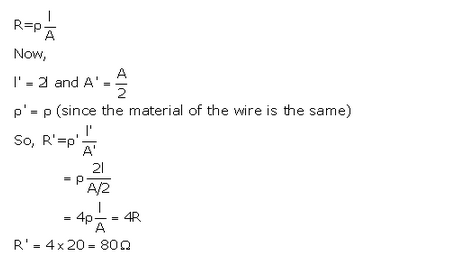
Question 34:
The electrical resistivities of three materials P, Q and R are given below :

Which material will you use for making (a) electric wires (b) handle for soldering iron, and (c) solar cells ? Give reasons for your choices.
Solution :
(a) Material Q with resistivity 2.63 X 10-8 ohm-m can be used for making electric wires because it has very low resistivity.
(b) Material R with resistivity 1.0 X 1015 ohm-m can be used for making handle of soldering iron because it has very high resistivity.
(c) Material P with resistivity 2.3 X 103 ohm-m can be used for making solar cell because it is a semiconductor.
Question 35:
The electrical resistivities of four materials A, B, C and D are given below :

Which material is : (a) good conductor (b) resistor (c) insulator, and (d) semiconductor ?
Solution :
(a) Good conductor = C (10 x 10-8ohm-m)
(b) Resistor = A (110 x 10-8 ohm-m)
(c) Insulator= B (1 x 1010 ohm-m)
(d) Semiconductor= D (2.3 x 103 ohm-m)
Question 36:
The electrical resistivities of five substances A, B, C, D and E are given below :
A 5.20 x l0-8 Ω m
Solution :
(a) E is best conductor of electricity due to its least electrical resistivity.
(b) C, because its resistivity is lesser than that of A.
(c) B, because it has the highest electrical resistivity.
(d) C and E, because of their low electrical resistivities.
Lakhmir Singh Physics Class 10 Solutions Page No:37
Question 1:
Give the law of combination of resistances in series.
Solution :
According to the law of combination of resistances in series, the combined resistance of any number of resistances connected in series is equal to the sum of the individual resistances.
Question 2:
If five resistances, each of value 0.2 ohm, are connected in series, what will be the resultant resistance ?